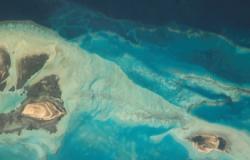Sea for Peace in the Middle East

Nelson Mandela once said, “It always seems impossible until it’s done.” He should know. Mandela, and others, vanquished perhaps the world’s second most divisive conflict: the wrenching apartheid system of South Africa. But still, the world’s most intractable conflict has yet to be resolved. That would be the Palestinian-Israeli conflict— a conflict frozen like an iceberg on the shores of humanity’s conscience for well over sixty years.
It has drained the creative and economic prospects of many generations of Palestinian and Israeli children. It has also sapped the civic and moral soul of both societies. It has trampled on all of their fundamental rights, most especially their right to live in dignity, in peace. These children deserve the right to peace.
The Arab-Israeli conflict that began in 1948 remains today an unconscionable tragedy in progress. And with each passing year, the one remedy that makes eminent sense—a two-state solution—appears to be receding, a once-and-future hope going slowly, slowly dark.
Which is why French president François Hollande’s effort to jump start a new round of peace talks in Paris last June was exactly the right thing to do—even without the Palestinians and Israelis joining in. As Robert F. Kennedy said, “Only those who dare to fail greatly can ever achieve greatly.”
What’s for certain is that the economic and security incentives now being formulated by the Paris participants to be put on the table later this year for consideration will have to be extraordinary to help the parties navigate the treacherous narrows, especially concerning Palestinian insistence on the “right of return” and the schism over the final status of Jerusalem.
But whatever incentives conference participants bring with them, we’d like to propose—with deep humility, being fully aware that greater minds have attempted to address these same issues over many years—the following ideas that we believe may serve as bridges to more successful negotiations.
On the Right of Return
Today, the United Nations Relief and Works Agency (UNRWA) estimates there are 5.15 million Palestinian refugees living in the Middle East. Of these, approximately 1.5 million eke out life in refugee camps. The Gaza Strip holds up to 1.26 million registered refugees, with another 500,000 relegated to permanent camps. In terms of areas defined by political boundaries with populations above 1 million, the Gaza Strip is the world’s third most densely populated, with roughly 5,000 people per km2. That places it just below Singapore and Hong Kong, which are thriving and affluent societies.
Currently, Gaza’s total population sits at 1.76 million, but is expected to rise to 2.1 million by 2020, adding another 500,000 or so to the already heavily urbanized and economically depressed area. (In 2015, the GDP per capita was US$ 1,273, which puts Gaza on a level with Mauritania.)
The West Bank is home to an additional 755,000 registered refugees, with another 228,000 or so dwelling in refugee camps.
Further afield, Lebanon serves as temporary sanctuary to 450,000 registered Palestinians. Unlike the 2.1 million refugees currently living in Jordan, who by and large have been generously granted full citizenship rights by the government, the ones in Lebanon are denied legal residency. Syria has also taken in some 560,000 Palestinians, but only about 450,0o0 remain there today, due to the raging civil war. Some have been tragically killed; others have fled for their lives to Europe.
Not including the Palestinian refugees granted citizenship in Jordan, and those currently located in the West Bank and Gaza, there are about 1 million refugees amassed in Lebanon, Syria and Europe, without home or citizenship.
Pertinent to the peace process, a 2005 opinion poll released by the Palestinian Association for Human Rights stated that 96% of Palestinians living in Lebanon refused to forgo their right of return.
And according to the Palestinian Center for Policy and Survey Research's (PSR) July 2003 poll, only 10% of those surveyed claimed that they be relocated to within Israel’s pre-1967 borders, while 71% declared a preference to remain in their current refugee country or take up residence in a future Palestinian state, including territories "swapped later on with Palestinian areas as part of a territorial exchange.”
Moreover, Hamas, itself a serious challenge to the success of the peace process, refuses to relinquish the right of return. Conditionally, Fatah appears to be more flexible.
A resolution of the right of return issue would be an important step in moving peace talks forward.
Accordingly, we believe that the return of at least 1 million Palestinian refugees from Lebanon, Syria and Europe to Gaza is achievable within ten years, if Hamas accepts Israel’s right to exist and agrees to live peaceably with it in the democratic construct of a new Palestinian state.
How is it possible to add another 1 million people to Gaza, in addition to the 2.1 million people expected to reside there by 2020?
Land reclamation. We believe that it’s possible to add about 54 km2 of new land to the Gaza coastline, creating an additional 15% in landmass, from 360 km2 to about 414 km2. This new area would provide ample space to accommodate Gaza’s projected 2020 population, as well as a modulated influx of at least 1 million refugees from Syria and Lebanon and Europe. Resolution of this issue would help catapult the parties towards a final settlement and make it exceedingly politically difficult for Hamas to refuse it.
For about a mile out, the seabed to the west of Gaza is only about 20m deep. This depth is well within reasonable limits to permit significant land reclamation. New land could be built out up and down the 21-mile coastline, while leaving 1.5 nautical miles sea gaps at the borders nearest Egypt and Israel. This would result in the creation of open new land for eco-housing, development, and arable cultivation.
Land reclamation has served small countries such as Singapore exceedingly well by permitting its expansion by over 22% since the 1960s. Hong Kong, UAE, Qatar and Bahrain have also employed it to increase necessary and valuable land. There’s no good reason why the same technique can’t be applied to Gaza, used as a creative tool to help propel the peace process.
The cost, of course, would be considerable, but the costs of this conflict in terms of human lives are incalculable. But if the land reclamation process can be done in an ecologically sustainable way, without resorting to the current practice of environmentally-damaging, seabed dredging techniques, a consortium of banks, including the World Bank and the European Bank for Reconstruction and Development, may well be willing to provide the necessary financing.
Realistically, the project could be completed in as few as 10 years by using a host of modern land reclamation techniques. Actual development of completed land areas could be done in multiple phases. The New Palestine eco-state project would cost at least US $50 billion, with housing and commercial development, in addition to new desalination plants, power grids and other infrastructure requirements to be funded through IPOs and a consortium of investors. Which seems like a lot, but in context and given the imperative, it’s actually not—not compared with the continuing costs of the conflict and the chokehold they have on the economies of the two parties.
A recent RAND study suggests that it may be well worth it, projecting nearly a 50% increase in GDP by 2024 for both Israel and a new Palestine under a two-state solution. Israel would stand to gain “in absolute terms” up to US $123 billion over ten years. A new Palestine would see up to US $50 billion, with an average per capita income rise of 36% above what‘s now forecast, in the same period.
The human costs of this deadly conflict are, of course, another matter altogether. According to Barry Buzan in his book “Regions and Powers,” Arab-Israeli conflicts since 1945-1995 have led to 74,000 military fatalities and 18,000 civilian deaths--a staggering number, which continues to grow. B’Tselem, the Israeli Center for Human Rights in the Occupied Territories, claims that there have been over 1,300 Israelis and nearly 9,500 Palestinians killed since the beginning of the Second Intifada in 2000.
When does this end?
Any realistic opportunity to build new, life-sustaining land from the sea should be explored by the two parties and incorporated into negotiations. Once the right of return issue is resolved, Hamas will be hard put to block momentum. Its acceptance of the state of Israel and the renunciation of all violence against it would be a major precondition for any forward movement.
Naturally, Israel would be obligated to grant the new Palestinian state title to the Territorial waters, Contiguous zone and Exclusive Economic Zone off of the Gaza Strip; but nothing under international law would prevent this final transfer of sovereignty. In fact, such a transfer of sea for peace would cost Israelis nothing.
Moreover, there’s no religious impediment that would prevent such an act. According to a 2016 Pew Research Center poll, 60% of Israeli Jews maintain that God bestowed the land of Israel on them, with as many as 85% of Israeli settlers concurring, including 99% of Haredi and Dati settlers. But the Torah makes no mention of the sea. The gift of the sea for peace may be given without religious reservation.
For such an act, Israel would achieve lasting security, to be monitored and guaranteed at the start by the international community.
On the Status of Jerusalem
Long has it been held that Jerusalem is the capital—for both the Israeli and Palestinian states, with the Palestinians referring to it as “Quds,” and the Israelis calling it the “City of David,” or Jerusalem. While many ideas have been put forward to resolve this sensitive and critical issue—everything from an international city to a shared capital city—we’d like to propose one more. That both the capitals of Israel and a new Palestine model themselves after South Africa’s capital. Which is not one, but four capital cities within a single state. In other words, there is no legally defined capital city. Cape Town serves as the seat of Parliament. Pretoria is residence to the office of the president and his or her cabinet. Bloemfontein is home to the judicial capital, the Supreme Court of Appeal, while the Constitutional Court of South Africa rests in Johannesburg. One state, four capitals.
By way of implication, the capital of Israel would be the whole state. The Knesset would be in Jerusalem; the prime minister’s office in Tel Aviv; the Supreme Court and High Court of Justice in, let’s say, Haifa.
Likewise, the capital of the state of New Palestine would be in East Jerusalem, Gaza City and Ramallah. With the three major governmental branches of legislature, executive and judicial located in separate cities of the state, the nation itself would serve as the capital.
In this way, there is no legally defined capital city for either state. The capital is the nation; the nation is the capital, for both, which would include, of course, Jerusalem.
While this may seem like a matter of semantics or just symbolic, it could actually be functional and in keeping with both countries’ democratic aspirations, as all major governmental institutions of both governments would be situated closer to the people than in most countries.
Moreover, neither Israel nor Palestine could claim that Jerusalem is their exclusive capital because the capital would constitute the whole of each state. Israel would be, in effect, the capital of Israel; New Palestine would be, in effect, the capital of New Palestine, with Jerusalem being only part of the capitals of each state: two states, six capitals.
On the Role of International Actors
As H.G. Wells once said, “Human history is, in essence, a history of ideas.” But for ideas to transform themselves into working realities, they require support from multiple spheres of influence, oftentimes concurrently.
Therefore, it is essential that international actors, including the European Union (EU), the United Nations, the United States, and Russia, the so-called Quartet, consider incorporating “sea for peace” and “two states, six capitals” in any future negotiations as a way to shift the dynamics.
None of these ideas are in any way inconsistent with the positions taken by any of these parties.
The EU’s position on the right of return of refugees, for instance, is that “a just, fair, agreed and realistic solution to the refugee question” must be found. They note that in the context of a two-state solution, the objective is a “contiguous Palestinian state living side-by-side in peace and security with Israel and its other neighbours.”
Regarding the final disposition of Jerusalem, the EU has consistently stated that “[a] way must be found through negotiations to resolve the status of Jerusalem as the future capital of both states.”
The US has also long supported “an independent, viable and contiguous Palestinian state as the homeland of the Palestinian people, alongside the Jewish State of Israel.” Currently, the White House is developing plans to advance the peace process before President Obama leaves office. Ideas include a United Nations Security Council resolution that would call for compromise on the part of both Israelis and Palestinians, and perhaps a master plan for any future negotiations. A joint statement by the Quartet, which has already cautioned that the two-state solution is “in danger”, is also under consideration.
The Quartet supports “Palestinian economic development and institution-building in preparation for eventual statehood.” Indeed, its Office of the Quartet, which is funded by the US, the World Bank, the Netherlands, Sweden, New Zealand, the UN, and the US Institute of Peace, helps facilitate, among other things, “Palestinian access to land to unlock economic potential.”
Finally, the Arab League, composed of 22 states, including Jordan, Lebanon, Syria and the Arab Republic of Egypt, and a crucial component in any search for a just and lasting peace, calls for normalizing relations between Arabs and Israelis in exchange for the “complete withdrawal by Israel from the occupied territories (including East Jerusalem) and a ‘just settlement’ of the Palestinian refugee problem, based on UN Resolution 194.” That resolution stipulates “refugees wishing to return to their homes and live at peace with their neighbours should be permitted to do so.”
Whether the Arab League will endorse the proposition that Palestinian refugees be given a grant of new, contiguous land--rather than the right to return to their old homes, in many cases long since disappeared, remains to be seen. However, it’s not outside the realm of reason that they would, in fact, embrace this concept to get their fellow Arabs a new homeland—a new Palestine—and a lasting peace, so long as a majority of the Palestinian diaspora living in Lebanon, Syria and Europe agrees.
Accordingly, both objectives—the guaranteeing the right of return to Palestinian refugees and their descendants, under a “sea for peace” stratagem, as well as the mutual enjoyment by both states of Jerusalem as part of their capital cities, under the “two states, six capitals” design—are entirely consistent with the principles enunciated by the major international actors invested in the peace process.
“Sea for peace” makes possible the building of a new homeland in an area contiguous with their new state for a significant number of returning refugees. It will also afford Palestinians a unique opportunity to advance their country’s economic development on a grand scale, with new trade, services and industries, and with access to arable land. It also opens up prospects for constructing the first genuine eco-city on the Mediterranean.
“Two states, six capitals” offers a definitive solution to the delicate issue of which state—Palestine or Israel—ultimately declares Jerusalem its rightful capital city. This formula, whereby the capital is the whole nation— of Israel, of Palestine— including, of course, Jerusalem, is compatible in every way with the position taken by the EU, for instance, that “[a] way must be found… to resolve the status of Jerusalem as the future capital of both states.“
More importantly, these two propositions honor the aspirations of both the Palestinian and Israeli people. They can help get the two sides to a final peace.
In July, UN Secretary-General Ban Ki-moon stated that “the region and the wider international community must exercise its influence to encourage both sides” to resolve this conflict. Clearly, a multilateral approach has merit should a consensus on a comprehensive peace plan’s intricate elements and ensuing negotiating tactics be settled on. But it is our belief that the chances of any peace plan succeeding are increased if the international actors, as well as the principals involved, consider some new thinking.
On Financing
The financing of the proposed project is a challenge, but in light of the world’s long-standing desire to put an end to the conflict, it is eminently feasible.
The World Bank
There are numerous financial institutions in place that are capable of contributing to the financing, building and development of a new Palestinian state. One potential partner is obviously the World Bank. Under its broad financial and expertise umbrella, there is the International Bank for Reconstruction and Development (IBRD). It provides “a combination of financial resources, knowledge and technical services, and strategic advice to developing countries, including middle income and creditworthy lower income countries.”
To do this, the IBRD raises funds from the global financial markets, and since 1946 has allocated over US $500 billion in loans to such countries. Middle-income nations are defined as those with a per-capita gross national income of between US $1,026 and around US $12,475 per year.
According to the UN, the combined GDP per capita for Palestinians living in the West Bank, East Jerusalem, and Gaza was US $2,801 in 2014, and is well within IBRD’s middle-income country funding guidelines.
IBRD’s financial reach is long. In 2015, it provided nearly US $3.5 billion in support for development projects in the Middle East and North Africa region alone. These included, among others, urban development, environment and natural resources management assistance, and agriculture. IBRD provides loans, guarantees and risk management products for development “across all sectors.”
In addition, the World Bank’s International Finance Corporation (IFC) reaches out to the private sector to encourage in-country development. To finance infrastructure and agribusiness projects, for instance, it issues debt obligations in capital markets. According to IFC, it borrowed approximately US $16 billion in 2014 and regularly “issues bonds in a variety of markets and formats” to assist private enterprises develop country-specific projects.
The IFC also partners with governments. Among them are, Australia, Austria, Canada, the European Commission, Finland, Hungary, Japan, Korea, Luxembourg, the Netherlands, New Zealand, Sweden, Switzerland, UK, and the US. Additionally, it works with the Bill & Melinda Gates Foundation, the eBay Foundation, the Ford Foundation, the Goldman Sachs Foundation, the Hindustan Unilever Foundation, the Kauffman Foundation, the MasterCard Foundation, the Omidyar Network Fund, Inc., the PepsiCo Foundation, and the Rockefeller Foundation.
IFC currently has field offices in the West Bank and Gaza.
The European Bank for Reconstruction and Development
Beyond the financial prowess of the World Bank, there is a high probability that the European Bank for Reconstruction and Development (EBRD) would consider participating in the buildup a new Palestine. The EBRD came into being, following the collapse of the Soviet Union in 1989, to support a new era in European history by contributing to the development of Central and Eastern Europe. The EBRD is committed to “market-oriented economies and the promotion of private and entrepreneurial initiatives.” It provides loans of up to US $280 million for country projects. It also invests in individual infrastructure and industry enterprises, up to US $112 million each.
The Arab League
Among the 22 member nations of the Arab League are the UAE, Saudi Arabia, Kuwait and Qatar. These four are among the wealthiest nations on Earth. Each controls significant sovereign wealth funds.
According to Forbes Magazine, the UAE controls the Abu Dhabi Investment Authority, the Investment Corporation of Dubai, the Abu Dhabi Investment Council, the International Petroleum Investment Company and the Mubadala Development Company. The projected combined worth of these funds is estimated at US $1.2 trillion. The UAE’s President, His Highness Sheikh Khalifa bin Zayed Al Nahyan, to his credit, recently called on the global community to save the faltering peace process.
Saudi Arabia owns the SAMA Foreign Holdings and the Public Investment Fund. Together these sovereign wealth funds are projected to be valued at nearly US $772 billion. Saudi Arabia is planning to expand its Public Investment Fund to US $2 trillion. King Salman bin Abdul Aziz of Saudi Arabia has recently been trying to become a more active participant in the peace process in a strategic attempt to blunt Iran’s influence in the region.
Kuwait’s sovereign wealth fund is known as the Kuwait Investment Authority. Its worth is an estimated US $592 billion. Despite tensions between Palestinians and Kuwaitis since the 1990-1991 Iraq-Kuwait war, when the PLO sided with Iraq against Kuwait, relations have begun to improve. Kuwait will likely support an international effort to build a genuine Palestinian homeland.
Qatar has built up has a wealth fund of between US $256-302 billion, according to Forbes. While Qatar’s support for Hamas is well known in the West, it is clear that Prince of Qatar, Sheikh Tamim bin Hamad bin Khalifa Al Thani, would welcome the opportunity to support a new era for the Palestinian people, in light of his country’s recent history of hiring Palestinian workers living in Gaza and the West Bank.
In total then, the sovereign wealth of these four Arab states adds up to nearly US $3 trillion, a considerable sum. Should a new Palestinian state require loans and investments of up to US $50-100 billion over 10-15 years to pay for 1) the creation of 54km2 of land and 2) a sustainable national infrastructure and housing, the financial resources appear to be well within reach.
Conclusion
Necessity may be the mother of invention, but audacity, in this case, may be the father of success. Thus, we respectfully offer a fresh equation for peace in the Middle East in the hope that it may contribute to ending the world’s most intractable conflict and relieve the suffering of millions.
The writer, Timothy Cooper, was a member of the Board of Directors of the Middle East Peace Civic Forum, a Washington, D.C.- based peace group in association with the J. William and Harriet Fulbright Center. From 2002-2010, he served as executive director of World Rights, specializing in human rights and environmental issues. Currently, he is leading a consortium of major
international companies to help assist low-lying nations mitigate, through ecologically sound land reclamation practices, the anticipated impact of global sea level rise.
Email: Info@timothycooper.net
![]()
Photo credit: NASA's Marshall Space Flight Center via Foter.com / CC BY-NC


